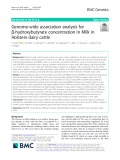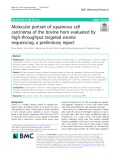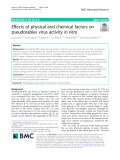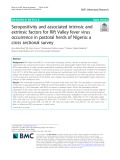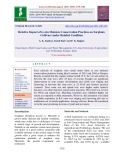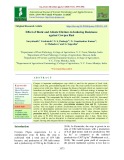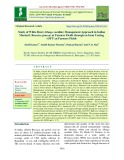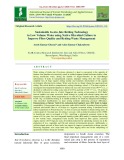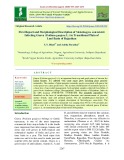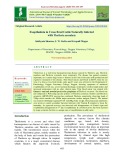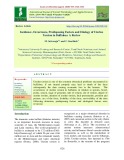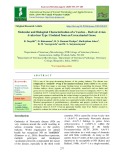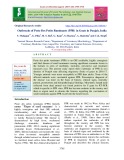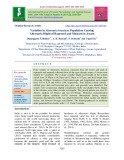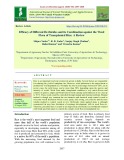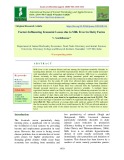
Farmer and losses
-
Ketosis in dairy cattle has been shown to cause a high morbidity in the farm and substantial financial losses to dairy farmers. Ketosis symptoms, however, are difficult to identify, therefore, the amount of ketone bodies (mainly β-hydroxybutyric acid, BHB) is used as an indicator of subclinical ketosis in cows.
 17p
17p  vihagrid
vihagrid
 30-01-2023
30-01-2023
 9
9
 4
4
 Download
Download
-
It is one of the most prevalent disease in Indian bullocks often resulting in death and huge economic losses to farmers. Here, we have reported the use of targeted exome sequencing to identify variants present in horn cancer affected horn mucosa tissue and blood of the same animal to identify some of the prevalent markers of horn cancer.
 7p
7p  vigandhi
vigandhi
 23-02-2022
23-02-2022
 9
9
 1
1
 Download
Download
-
Endometritis is a prevalent uterine disease in postpartum cows. The disease reduces fertility performance and milk yield, and subsequently, productivity and profitability of dairy farms. The reduction in performance is associated with considerable economic losses on dairy farms.
 11p
11p  vigandhi
vigandhi
 23-02-2022
23-02-2022
 10
10
 1
1
 Download
Download
-
Pseudorabies (PR) is latent and can persist in infected sows for a long time, and thus, convalescent sows can carry the virus throughout life, causing severe economic losses to farmers and posing a tremendous challenge to PR prevention and control. Here, to investigate the biological characteristics of pseudorabies virus (PRV), a variety of physical and chemical factors were analyzed under controlled conditions.
 10p
10p  vigandhi
vigandhi
 23-02-2022
23-02-2022
 17
17
 1
1
 Download
Download
-
Rift Valley fever (RVF) is a vector-borne emerging zoonotic disease of animals and humans, characterized by socioeconomic losses to livestock farmers and global public health threat. The study determined RVFV seroprevalence in cattle, assessed pastoralists’ knowledge about RVF, and factors that influence its occurrence in pastoral cattle herds of Nigeria.
 10p
10p  vigandhi
vigandhi
 23-02-2022
23-02-2022
 12
12
 1
1
 Download
Download
-
Four cultivars of sorghum were tested under three in situ moisture conservation practices during kharif seasons of 2015 and 2016 at Kanpur. Results revealed that the organic residue mulch @ 4 t ha-1 on soil surface in between the crop rows after 25 days of sowing brought out significant improvement in crop canopy development and yields over ridging and furrowing in between the crop rows at 25 DAS and farmer's practice (control).
 7p
7p  trinhthamhodang11
trinhthamhodang11
 27-04-2021
27-04-2021
 18
18
 1
1
 Download
Download
-
The nationwide imposition of lockdown due to Covid-19 adversely affected various agriculture allied occupations especially livestock and poultry sector. For dairy farmers reduced price of milk, lack of transportation means and lack of veterinary aids were major problems faced during the lockdown. Poultry farmers incurred massive losses due to rumours associated with chicken which caused collapse in demand for poultry products. Top ranked problems faced by poultry farmers include reduced availability of improved breeds, price and sale of egg or meat.
 5p
5p  caygaocaolon11
caygaocaolon11
 21-04-2021
21-04-2021
 16
16
 1
1
 Download
Download
-
Cowpea is important multipurpose crop which is used for the purpose of food, feed, forage, catch crop, green manuring and cover crop. The crop is prone to rust disease which causes severe yield loss. Hence to manage the disease chemicals which are expensive and hazardous are usually used by the farmers. Alternately a different strategy to manage the same was experimented with the use of elicitors which are compounds which activate chemical defence in plants and this induced defence response in susceptible variety C-152 was examined.
 9p
9p  caygaocaolon11
caygaocaolon11
 21-04-2021
21-04-2021
 11
11
 2
2
 Download
Download
-
In India, oilseed Brassica are grown over an area of about 6.3 million hectares with an annual production of 7.92 million tones with an average yield of 1304 kg/ha whereas in Rajasthan it was still 1422kg/ha. The severe attack of many diseases not only deteriorates the quality of the seed, but also reduces the oil content considerably. Among the diseases, white rust caused by Albugo candida (Pers. Ex Hook) O. Kuntze, is an important disease of a wide variety of Brassica crops. Its infection causes disfiguring white pustules on leaves, flowers stems and pod leading to yield losses.
 6p
6p  chauchaungayxua10
chauchaungayxua10
 19-03-2021
19-03-2021
 16
16
 1
1
 Download
Download
-
Water retting of whole jute (Corchorus olitorius L.) plant is convenient to the majority of farmers. Jute bundles are extensively retted in isolated stagnant inland freshwater bodies, often having insufficient water, during the months of August–October in the Indo-Bangla subcontinent. It leads to transportation expense, improper retting with low fibre quality, complete loss of huge organic retting residue and transitory deterioration of the aquatic environment affecting local ecology.
 20p
20p  chauchaungayxua11
chauchaungayxua11
 23-03-2021
23-03-2021
 7
7
 2
2
 Download
Download
-
Pigeonpea (Cajanus cajan (L.) Millsp.) is one of the major pulse crop of tropics and sub tropics, cultivated by small and marginal farmers under rainfed condition. It is known to be affected by many fungal diseases among them dry root rot caused by Rhizoctonia bataticola (Taub.) Butler, is a major soil borne disease causing considerable yield loss in most of the pigeonpea growing regions of India more so in the North-Eastern Karnataka.
 8p
8p  cothumenhmong9
cothumenhmong9
 18-01-2021
18-01-2021
 11
11
 2
2
 Download
Download
-
Guava (Psidium guajava L.) is an important fruit crop and good source of income for Indian farmers. It’s infested with some major pests including plant parasitic nematodes. The number of plant parasitic nematode species associated with guava but some species are cause great losses. The accurate identification of nematode species is a basic key of successful management. Soil and plant samples collected from fields of guava from Arathwara village, Sheoganjtehsil, Sirohi district of Rajasthan, India on the GPS location 250 03’40.7”N; 720 58’05.0”E.
 8p
8p  trinhthamhodang9
trinhthamhodang9
 16-12-2020
16-12-2020
 8
8
 1
1
 Download
Download
-
Aquaculture plays a major role in augmenting food production, levelihood and thereby the economy of a country. Andhra Pradesh is the leading state in cultured shrimp production, value and exports. Increasing intensification of shrimp aquaculture, devoid of awareness on scientific farming practices among farmers, spurious seed and water pollution, exerted disease problems. Diseases in shrimp farming are a recurring problem and the future is dwindling and farmers are facing heavy losses.
 13p
13p  trinhthamhodang1216
trinhthamhodang1216
 19-11-2020
19-11-2020
 14
14
 2
2
 Download
Download
-
Theileriosis is a tick borne haemoprotozoan disease caused by Theileria spp, Theileria annulata and Theileria orientalis most commonly. The disease has gained economic importance as it causes huge losses to farmers in the form of decrease milk production and expensive treatment of the disease.
 5p
5p  trinhthamhodang1216
trinhthamhodang1216
 19-11-2020
19-11-2020
 16
16
 3
3
 Download
Download
-
Uterine torsion is one of the common obstetrical problems encountered in buffaloes, if not treated properly may lead to death of the fetus subsequently the dam causing economic loss to the farmers. The occurrences of uterine torsion in buffaloes in relation to species, breed, parity, season, stage of gestation, side of torsion, site of torsion, degree of uterine torsion, duration of uterine torsion, fetal presentation, position and posture, sex of the fetus, livability of the fetus, survivability of the dam following detorsion, predisposing factors and etiological factors were reviewed.
 8p
8p  trinhthamhodang1216
trinhthamhodang1216
 19-11-2020
19-11-2020
 4
4
 1
1
 Download
Download
-
ND is one of the most devastating diseases of the poultry industry. The disease was categorized as ‗notifiable‘ owing to the immense economic losses caused to the poultry farmers. Wide host range is one major limiting factor in controlling the disease. While chicken, turkeys, doves, pigeons are highly susceptible, waterfowls such as ducks and geese are less susceptible and considered as natural reservoirs for lentogenic AAvV-1.
 9p
9p  trinhthamhodang1216
trinhthamhodang1216
 19-11-2020
19-11-2020
 8
8
 2
2
 Download
Download
-
Peste des petits ruminants (PPR) is an OIE notifiable, highly contagious and fatal disease of small ruminants causing significant economic losses to the farmers in term of morbidity, mortality, preventive and treatment measures cost. The present study report three outbreaks of PPR in two districts of Punjab state affecting migratory flocks of goats in 2016-17. Younger animals were more susceptible to PPR than adults. None of the affected animals were vaccinated against PPR.
 6p
6p  angicungduoc8
angicungduoc8
 07-11-2020
07-11-2020
 7
7
 2
2
 Download
Download
-
In Assam, though large scale survey has not been carried out on the total loss caused by the Alternaria brassicae but reports from farmers’ field about the disease is alarming requiring a full scale study to understand the variability of Alternaria brassicae to help develop management strategies.
 13p
13p  angicungduoc8
angicungduoc8
 07-11-2020
07-11-2020
 16
16
 2
2
 Download
Download
-
Rice is an important food crop extensively grown in India. Several factors are responsible for reducing the yield of transplant rice. However, weed infestation is the major threat to productivity of transplanted rice. Normally the loss in yield ranges between 16-20%, yet in severe cases the yield losses can be more than 50%, depending upon the species and intensity of weeds.
 12p
12p  caygaocaolon7
caygaocaolon7
 18-09-2020
18-09-2020
 10
10
 2
2
 Download
Download
-
Milk fever is the common disease and one among the important metabolic disorder in lactating dairy animals. It is an afebrile hypocalcaemic disease of cattle usually associated with immediately after parturition and initiation of lactation. Milk fever is a metabolic disease occurring in dairy animals during parturient period and management is economically most important, as it results in not only reduction in milk production but also loss of animals.
 4p
4p  caygaocaolon7
caygaocaolon7
 18-09-2020
18-09-2020
 14
14
 1
1
 Download
Download
CHỦ ĐỀ BẠN MUỐN TÌM









